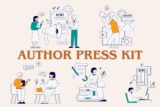Published: April 11, 2023
The Simple Tool Independent Authors Can Use to Reach Millions of Readers and Sell More Books
An e-book is an invaluable tool for independent authors who are interested in increasing readership and selling more books. While e-books didn’t kill print books, it’s a format that can’t be ignored.
Close to 200 million e-books were sold in 2020, demonstrating consistent annual increases since 2018, with 30 percent of readers preferring them to print or audiobooks.
Advantages of E-book Publishing
There are lots of reasons for this:
- Cost: e-books often cost less than print books and the buying and borrowing options are more extensive than print books.
- Reader-friendly features: for some readers, being able to search the text, customize the screen, and carry dozens—if not hundreds—of books on a tablet is now a way of life.
- Greater and faster accessibility: E-books can be downloaded instantly from anywhere in the world, making them accessible to readers who might not have access to a printed book, or don’t want to wait for shipping.
- Easy to distribute: E-book distribution is straightforward and can be done through online retailers or directly from the author’s website.
- More environmentally friendly: E-books are often seen as a more environmentally friendly option since they do not require paper or ink and they can be read on devices you already have.
So, if you have published a print book but not an e-book, you are missing out on the tremendous potential for a larger audience and expanded marketing options.
How E-book Publishing Works
Fortunately, you can always add an e-book edition to your stores. If you are in the publishing process, we strongly recommend publishing the digital edition along with the paperback edition.
A true e-book uses text that has been formatted using HTML code. This allows the reader to adjust their preferences (screen size, text size and color, etc.) but still retain the attributes of the book text, such as italics, page and scene breaks, or any other text formatting. If coding sounds scary, don’t be intimidated—e-books can be created from print book files or from text documents. The resulting file is a .epub file that usually embeds the front cover in it.
Once you have a file, your options for e-book distribution reach far beyond your print options. While we recommend using KDP and IngramSpark for print distribution, which makes your print book available through many channels, e-book distribution has more options, and it’s important to consider them and pick the best ones for you.
Optimizing YOUR E-book Distribution
As said, there are many ways and combinations you can use to distribute your e-book.
Here are some of the common options:
- Set up accounts with each individual site that sells e-books, such as KDP, Kobo, Apple Books, Scribd, and dozens more.
One count says there are over 55 e-book retailers out there. Each site will have specific guidelines and formatting requirements, so for instance, a book summary you upload one place might not be accepted at another. They will also have different royalty amounts and reporting systems, so you’ll be keeping track of income in a few different ways. As far as royalties go, uploading to individual sites will probably net the most in royalties, so if you’re willing to trade some time and suffer some headache, it could be worth it.
| PROS | CONS |
|---|---|
|
|
- Distribute through IngramSpark.
| PROS | CONS |
|---|---|
|
|
- Use a specific e-book aggregator.
| PROS | CONS |
|---|---|
|
|
Best Websites and Aggregators for E-book Distribution
Amazon Kindle Direct Publishing (KDP)
Amazon Kindle Direct Publishing (KDP) is probably the first store you want to consider. While solid market share data are hard to have, most analysts consider that Amazon generates between 50 and 80% of the e-book sales in the U.S.
- Free to publish.
- They give either 35% or 70% of royalties depending on book pricing.
- You can make all editions available, letting the reader choose.
- They reach millions of readers every day
The Kindle Unlimited (KU) Option
Along with the standard distribution on Amazon, KDP offers a marketing and distribution option called KDP Select. KDP Select is a program that allows you to offer your book exclusively through KDP for a limited time. While the program has some benefits, it also has quite a few restrictions. There’s a 90-day opt-in period, and during that time sales through other outlets, even your website, are not allowed. Your book will be available for the Kindle Unlimited program, and you will be paid, not by download, but by the number of pages read.
Barnes & Noble
Barnes & Noble is the largest bookstore in the U.S. and the second online store for e-books thanks to their Nook reader.
- Free to publish.
- They give 70% of the retail price for books published with B&N Press.
- You can make all editions available, letting the reader choose.
Draft2Digital (D2D)
Draft2Digital (D2D) is an aggregator that allows creating, distributing, and selling e-books. Authors can create and upload their books and distribute them through D2D to most online stores, including Apple, Kobo, and Nook.
D2D seems to have a good track record, and to be the easiest to use. Among other options, D2D offers book formatting services, too.
They recently purchased Smashwords, another e-book aggregator, a move that offers some significant perks to authors. For instance, D2D users can now access Smashwords’ good book marketing tools.
- They take 10-15% of net revenue.
- Easy sharing features like a universal book link authors can create, which offers readers options about where to buy the book, and let them set it as a default. The link gives you data about readers’ preferences, and it’s easy to update.
- D2D gets to libraries through Overdrive.
- D2D has a print program, but it’s still in beta, and the return per book seems to be awfully small.
PublishDrive
PublishDrive is similar to D2D in its wide e-book distribution offer. Compared to other aggregators, PublishDrive does not take a percentage of your royalties, but it charges you a monthly fee for its service.
- It doesn’t offer book formatting options.
- Monthly cost after a trial period – $19.99
- Doesn’t take a commission.
- It provides book marketing tools, like direct access to Amazon Advertising.
BookFunnel
BookFunnel is not an aggregator but a tool authors can use to distribute e-books on their own. Using it means that you won’t pay a percentage of your book to anyone. BookFunnel does have a yearly fee, but it’s nominal, especially when starting out.
- Book funnel can help grow your email list
- If you select the Mid-List + Integration option, BookFunnel offers direct mailing list integration: every time you have a new subscriber, BookFunnel automatically adds them to your list. You can offer epubs and pdfs for free too through BookFunnel which can help with marketing.
- You keep all the royalties
- BookFunnel allows you to sell directly from your website.
- BookFunnel has a direct integration add-on that allows you to integrate a supported sales platform. The author pays through that platform, and BookFunnel provides the deliverables.
- Each sales platform takes a different percentage that varies from 5% – 6% per transaction, generally. Platforms include Gumroad, Payhip, Shopify, WooCommerce, and PayPal.
BONUS
Download now
DOWNLOAD OUR GUIDE ON HOW TO SET UP YOUR BOOKFUNNEL ACCOUNT.
Our recommendation:
- Unless you are a genre writer who KNOWS your clients read through Kindle Unlimited (KU), we recommend that you upload to a few sites where you think you’ll generate the most sales, at minimum, KDP, but you might consider Apple, B&N, etc.
- Then use an aggregator—we like Draft2Digital—for everyone else. It can’t hurt to have your book out there on multiple sites, and you only pay for it if you make a sale.
- If you discover you are making a LOT of sales through other markets, you might consider switching either to an individual account, or to a site like PublishDrive, which has a monthly fee.
- If you have a robust personal email list, or want to grow one, go ahead and set up BookFunnel. Sales won’t be logged on other sites, but it might pay off in growing your email list and more significant royalties.
Addendum: Using Kindle Unlimited
- KDP Select is not a publishing choice, it’s a book promotion choice. KDP allows you to access book promotion tools, such as free e-books, giveaways, or contest prizes through your website.
- Most authors, I’ve observed, make the decision to go broad, as I’ve described above, rather than limiting their distribution outlets. But for certain types of genres, like romance, the audience through Kindle Unlimited is huge, so it might be worth considering.
- If you are interested in this option, research it and see if it works for you, but DON’T publish your book anywhere else first.
Some of the links on this blog post may be affiliate links. This means that if you go through them to make a purchase, Luminare Press will earn a small commission without affecting your price.The decision is yours, and whether or not you decide to buy something is completely up to you.



